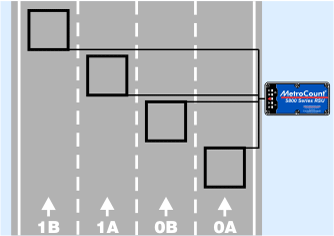Event Count reports are used to analyse simple "count" data, typically collected using single axle sensors or vehicle sensors, such as loops. Event Count reports support time-stamped datasets, and binned datasets from RSUs that have a binned-count mode.
The definition of an event is known as the Count Method, which is set via an Event Count report's Local Profile. The Count Method can be a combination of raw counts, counts with a division factor, or gaps for time-stamped data.
The two inputs (A and B) from each dataset included in an Event Count report can independently contribute to the totals by adding, subtracting or excluding them. This is known as the Input Contribution. For example, given the Split sensor layout shown below using tubes, counts for the two lanes can be derived from the B input for the left lane, and A - B for the right line.
Note that since events can be subtracted via the Input Contribution, this can result in negative totals. The meaning of a negative number is entirely application dependent. For example, the net flow at a point could be reported by adding inward inputs, and subtracting outward inputs.



